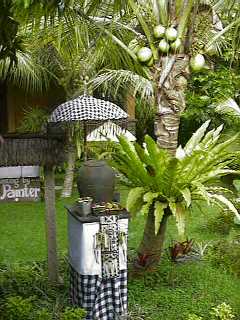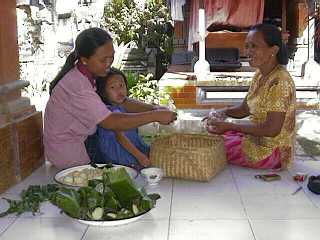
My first night here, I went to visit Ibu Warung Santai. (Her real name is Wayan Loka, but that's what we call her.)

When I first came to Bali with the gamelan (Balinese orchestra)
I play with, we stayed at a homestay in Banjar Kalah (I'll tell you more
about what that means later) in the town of Peliatan, where Ibu's
(Mom's) warung
(food stall) is. We used to
eat at Ibu's all the time, partly because it  was
so close but more because it was a great place to santai (relax) and
because Ibu serves some of the meanest nasi campur around--pronounced
"chom-poor" ("c" is "ch" in Bahasa Indonesia); literally "mixed rice" and meaning
rice with mixed vegetables, tofu, tempe (fermented soybean cake), sambal
(crushed chili peppers) and meats. At a great price, too -- still
only about 2500 Rupiah, which is about 35 cents! (By the way, if you
want to see how I'm spending my money and what things cost here, you can check
out the Expense Log on this site.) Ibu has a huge
family, too, and they're always fun to visit.
was
so close but more because it was a great place to santai (relax) and
because Ibu serves some of the meanest nasi campur around--pronounced
"chom-poor" ("c" is "ch" in Bahasa Indonesia); literally "mixed rice" and meaning
rice with mixed vegetables, tofu, tempe (fermented soybean cake), sambal
(crushed chili peppers) and meats. At a great price, too -- still
only about 2500 Rupiah, which is about 35 cents! (By the way, if you
want to see how I'm spending my money and what things cost here, you can check
out the Expense Log on this site.) Ibu has a huge
family, too, and they're always fun to visit.
Ibu was as thrilled to see me as I was to see her. "Aduh! Wayan Avi!!" she exclaimed, coming out to give me a big pat on the back. You'd rarely see a Balinese man and woman hug in public, even if they're married, though men often hold hands with other men and women with other women as they walk along.
"Ibuuuuu!!! Apa kabar, jegeg?" ("Ibu! What's up, babe?"), I joked.
"Ah! Avi sudah gemuk (fat)", she replied, with the usual brutal honesty of the Balinese. (One of the first questions you get asked here, by total strangers even, is "Sudah kawin?" -- "Are you married?", and if you're not you can't say "Tidak" -- "No" but rather "Belum" -- "Not yet", even if you never intend to be married.)
We laughed, and she invited me in to her home. The Balinese have a well-deserved
reputation for hospitality, as do Indonesians in general. Walking in through
their candi (gate) was like a blast from the past.


This is the candi (pronounced chon-dee) at the entrance to Ibu's house. The sign tells you how many people live there: four laki-laki (men), seven perempuan (women), and eleven jumlah (total). Actually, though, Ibu lives with: her brother; her three sons, their wives and their eight children; and two of her five daughters, one of whom is married and lives there with her husband and two children. (Her other daughters have moved away to live with their husbands' families, according to Balinese tradition.) The actual total is TWENTY-ONE people! This is an average to large size extended family. (Ibu had a ninth child who would have been the third Wayan, but he died after being alive only seven days.)
Families are vitally important to the Balinese. If you're Balinese, your parents usually have to approve your choice of marriage partner, and may even choose her/him for you. It is considered respectful to wait until your older brothers and sisters are married before marrying yourself, too. Respect for elders is central, and you're expected to take care of your parents in old age. You may even be expected to give up things to help a family member, for example to pay for an older sister's schooling. Basically, the good of the family comes before the desires of the individual. Is it that way in the U.S.?
Ibu's oldest child's name is Wayan, as in all Shudra caste families (whether it's a boy or girl), followed by Made, Nyoman and Ketut. With the fifth child, the cycle starts over again with Wayan! To avoid confusion (like in Ibu's family, where there are two Wayans, two Mades, etc.), there are nicknames: here, the oldest Wayan is called by his second name, Sarna, and the fifth by her second name, Balek. In higher caste families, other names are used, such as "Putu" instead of Wayan or "Ida Bagus" (for men) and "Ida Ayu" (for women) in Brahman families. In Kshatriya (warrior caste) families, "Dewa" is a common name.
The caste system in Bali is not as strict as in India, though. You can
do any job no matter your caste, and marrying between castes is allowed
and even common. Still, castes have an effect on daily life: there
are even separate languages to speak to people of different "levels"!
The TV was on behind us (yes, everyone has a TV here) with news about the demonstrations and riots in Jakarta. It drew our attention away from the conversation every so often. Everyone is happy it's not going on in Bali, but they support the students strongly.
Ibu returned with some tea, some krupuk (shrimp chips) and a plate of nasi (rice) with babi guling (roast pig), a special dish for the holiday. Usually when a guest visits, tea will be served and everyone will wait modestly until the guest drinks (after waiting a little while) before joining in the meal. I felt a little shy because I was the only one served food (they had just finished eating) and wanted to be halus (polite), but Ibu assured me it was OK and not kasar (rude) to go on by myself.
The first thing I'd wanted to do was to offer my sorrow to Ibu, for I'd heard that Bapak (Father), her husband, had been hit by a car two years earlier and passed away. (Traffic is CRAZY-DANGEROUS here!) She looked a bit sad, and thanked me for my thought. Then, she quietly sat down next to me.
"Braun--sudah mati, juga." ("Braun is dead, too.")
Braun was their dog. Most Balinese dogs are mangy and surly, and frankly Braun was no exception. For the first month I knew him, he would bark and snarl and growl at me like he would at everyone else. For some reason, though, I liked him, and thought he could be "tamed." One day, I gave him a krupuk. (Well, I didn't really "give" it to him -- I had to throw it to him from about twenty feet away; he still turned and ran, then returned to it, sniffed it and then, finally, ate it.) I kept doing this every day, gradually throwing the krupuk closer and closer. Ibu's family thought this was hilarious -- just the thought of "taming" a dog was ridiculous to them, I think, and to do it with krupuk was just too funny for words. On the last day, though, I finally achieved success: Braun ate the krupuk right out of my hand, and I even got to scratch him for a second behind the ear. (He sort of pulled away, but also pushed his head toward my finger a little, so I knew he really liked it, but just couldn't let everybody who was watching know that.) They were amazed!
So, it was really touching when Ibu told me about Braun's death. Wayan told me it was probably from something he ate, because he got sick before passing on. I said, "You should have served him krupuk." Everyone laughed, and I put a krupuk from my plate next to a banten (offering) on the bale. "Untuk Braun" ("For Braun"), I said, and we all laughed again. (You can probably tell already that most Balinese like to laugh, a lot!)
It was a great way to spend my first night!
You can always tell what time of day it is by the sun and the sounds. Each time of day even has its own name: pagi (early morning), siang (late morning/early afternoon), sore (late afternoon), malam (evening) and pagi-pagi (deep of night). ("Good morning" is "selamat pagi"; "good evening" is "selamat malam"; etc.) It all makes sense when you're here. When I went to bed late malam, it was dark and cool, but the noise was almost deafening! The frogs in the nearby sawah (rice fields) make this indescribable sound -- it's not like the croaking you probably think of frogs making, but a sort of rat-a-tat like a machine gun, only earthier. And there are dozens, even hundreds of them going at it, all at once. Their croaking creates this loud, rhythmic sound. (It's often said that this sound was the inspiration for Balinese gamelan music, which I'll tell you more about later.) At the same time, geckos and cicaks up in the ceiling let off their eerie "ECK--Ooooh" every once in a while. Chirping cicadas (crickets) add to the cacophony. It lasts pretty much all the way through pagi-pagi, so it's a wonder you can sleep at all (but you do!)
As the sun rises to announce pagi, the sounds of cocks crowing emerge along with waves of cricket cries that are like crashing, pulsing walls of sound. Cats hiss, birds chirp, dogs bark, motorcycle engines wail, and hammers start pounding as farmers go to the fields and others start working at the crack of dawn. Everyone gets in their few hours of work before siang hits and the heat becomes too great to do anything productive. Siang is a time of quiet as people and animals take a nap to escape the heat, and the chirping of the birds emerges as the dominant sound. Sore comes as a relief, and as the heat dies down people go back to finish up their work, perhaps washing up in a nearby river or stream as the sun goes down and a new malam arrives. It's the same cycle every day, and even the sun sets at pretty much the same time all year round this close to the equator. The only really big difference is when the monsoons hit and bring the rainy season, and a deluge of rain comes along (usually for a short time) to temporarily disrupt the routine.
The other schedule change is when it's a holiday -- like now! A lot of people's energy goes into the holiday, making the banten (offerings) like in these photos and spending a lot of time visiting each other and the local puras (temples) for prayers.


Much of Balinese daily life, and definitely celebrations like Galungan, are connected to their religious beliefs. The Balinese are Hindu -- actually, Bali has the only Hindu culture in Indonesia! Their Hinduism is mixed with animistic beliefs (that spirits live in everything, from people to animals to plants and rocks and the air). Those beliefs were here even before Hinduism arrived from Java (which received Hinduism from India, its place of origin). Here's another case of different cultures coming into contact and creating something new! You can see it in religious ceremonies, and especially in music and dance. I'll tell you more when I visit a temple ceremony and music/dance performances later.
I woke up my first morning here happy that it was the second day of Galungan, called Umanis Galungan (or, sometimes, "Sweet Galungan"). It is a joyous day of people visiting each other. Getting out of bed from under my mosquito net (the worst part of tropical life to me is the mosquitoes!), I headed out to the bale for a lazy breakfast of banana fritters, fruit (bananas, papaya, watermelon and pineapple) and kopi Bali (Balinese coffee) and to plan my day.


First stop: Dewa and Emiko's! Dewa Beratha (can you tell his caste from his name?) is a master musician, good enough to be sent to the U.S. to teach the gamelan I play with in El Cerrito, CA called Gamelan Sekar Jaya. He is also a great set designer, painter and dancer, and I'm sure does many other things I'm not even aware of. Emiko Susilo is also a good friend of mine from the group, for which she was a brilliant dancer and teacher. She is a Javanese-Japanese-American now living in Bali (wow!). Emiko also studied Southeast Asian cultures at the University of Hawaii, and has taught me a lot of what I know about Balinese culture.

This photo of Dewa and Emiko is from their wedding reception in Los Angeles, which I attended just before going to Hawaii. (I like it because the pumpkins have Balinese-style carving.) They got married this past summer in Bali. To do so, Emiko spent days going through all the coming-of-age rituals a Balinese person would go through from birth to marriage: numas gumi, a birth ceremony meaning "buying the world"; tigang sasih, where a baby's feet, at three months old, are first allowed to touch the ground; otonan, the first birthday celebration; and a potong-gigi, or tooth-filing, which is symbolic of becoming an adult and casting off the sins of jealousy, fraud, anger, greed, lust and pride. It's pretty amazing -- and certainly a 20th-century event -- that two people from lands so far apart can be married, don't you think?
Luckily, Dewa and Emiko returned to Bali in time for Galungan -- and my visit, of course. Balinese hospitality again: it's OK to just drop by without calling first, and that's what I did. Their home is a beautiful one, as you can see.



These shrines (first photo) are part of every Balinese home, and are
built to honor the family's ancestors as well as the gods. While I was
there, I got to see two interesting activities: Dewa's Ibu and sister making
banten for Galungan (middle photo), and a dance lesson (last photo) led
by Nyoman Cerita and Emiko. (I think it's great that the men here learn
women's dances; not only the teacher was a man, but a couple of the students,
too!) It's easy to lose track of time here: I think I spent four
hours just talking, relaxing and watching what was going on!
I had to move on, though, because Ibu Loka's family had invited me
to a special event in Banjar
Kalah. All I could understand was that it had something to do
with climbing a tree. Unfortunately, my camera's batteries died,
which is too bad because this was LUCU sekali (very funny)! I arrived
to see a massive crowed around a 20-foot-tall pinang pole that was
greased with oil. At the top was a maze of wires, with colorful prizes
dangling in the air. The idea of this "Raja Kuningan" (which happens
at many holidays) was for the youth of the village to work hard together,
in the spirit of gotong-royong (mutual help and cooperation) to
get to the prizes. it's harder than you think! It took them at least an
hour to accomplish the task, and believe me, these kids are GREAT tree
climbers.
First, they tried having one climb onto another's shoulders, and a third climb up the backs of the other two; but this just had them falling backwards off the pole. Another time, the bottom guy crouched down, another crouched on his shoulders, a third on his and a fourth on the top; they all tried to push up together, but the weight was too much to bear at the bottom and when he crumbled the whole lot came crashing down, to a roar of laughter from the crowd. The funniest time, though, was when one really small kid came sprinting up and stepped into the locked-together hands of the strongest one, who boosted him up onto the pole in one motion; the little one scrambled up and got about a foot from the top, reaching, reaching...and then slowly, slowly came sliding down, his eyes still locked upward on the prizes and his right hand still futilely grasping at them. When the finally did succeed, it was this little one who got to the top. Talk about a clown! He actually got into a pair of pants still on the hanger and hung there in the air, mugging for the crowd, much to their delight.
If you want to see more of this, I DID at least get good slide photos and even some video you can see when I get back!
Well, that's it for my first installment. Now it's YOUR turn to participate! What do you want to know more about? What do you want me to look for and send photos of? I'm going to a couple of schools next week -- what do you want to ask students your age here about life in Bali? I'm also going to interview Daniel, a friend of mine who lives at the homestay where I'm staying. He's ten, and half-German/half-Balinese. What do you want me to ask him?
Ask your teachers the best way to get in touch with me. I want you to
help me make this trip interesting and fun, for you as well as me!!